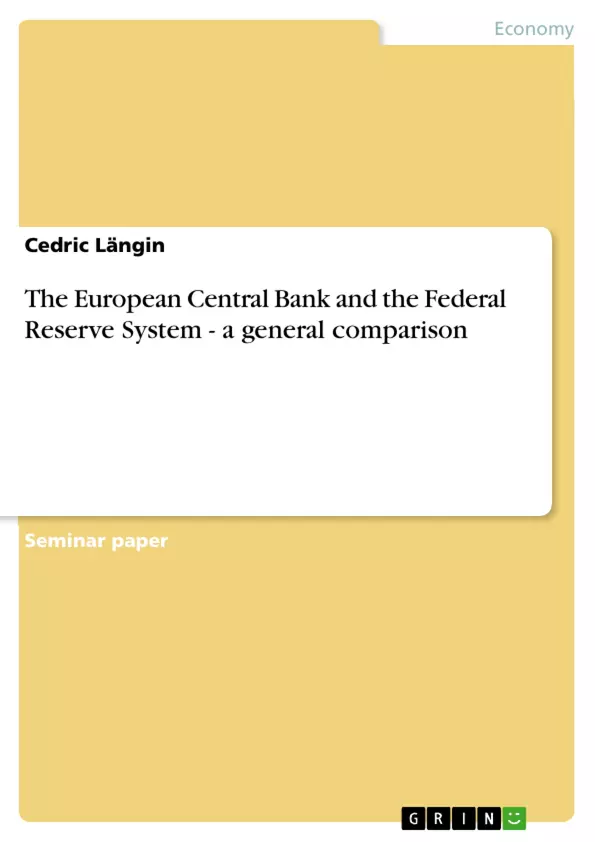Since the foundation of the European currency union in 1998, the European Central Bank and the Federal Reserve System represent the most influential two central banks in the world.
In this comparison their general structure, tasks and objectives and monetary policy instruments are contrasted. The institutions and bodies of the banks are explained in the second chapter, to see the structural differences. While the ECB defined price stability as its primary objective, the Fed has several equal objectives. These objectives and further tasks of the central banks are described in the third chapter. To steer and implement their objectives and tasks, the central banks have monetary policy instruments at disposal, whereas open market operations and the minimum reserve system play a key role. These instruments are explained in chapter 4 in general and their arrangement and implementation at the example of the ECB. Then the Feds corresponding instruments are contrasted with the ECB, because in my opinion the ECB has a role model position, in this context. Then follows an elaboration of the instruments standing facilities and discount policy. These instruments are examined in two separate subchapters, due to the fact that the implementation of these instruments is only made by the ECB or the Fed.
In the last part I examined the reactions of the ECB and the Fed to compensate the risks of the current financial crisis. The attention is directed to the evaluation of the quality and effectiveness of the implemented monetary policy instruments. At the end the results are summarized.
Inhaltsverzeichnis (Table of Contents)
- 1 Introduction
- 2 Institutions and bodies
- 2.1 The European Central Bank
- 2.1.1 The Eurosystem and the European System of Central Banks
- 2.1.2 Decision-making bodies of the European Central Bank
- 2.2 The Federal Reserve System
- 2.2.1 Board of Governors
- 2.2.2 Federal Open Market Committee
- 2.2.3 Twelve Federal Reserve Banks
- 3 Tasks and objectives
- 3.1 Tasks and objectives of the European Central Bank
- 3.1.1 Price stability as the primary objective
- 3.1.2 Miscellaneous tasks of the European Central Bank
- 3.2 Tasks and objectives of the Federal Reserve System
- 4 Monetary policy instruments
- 4.1 Open market operations
- 4.1.1 Open market operations of the European Central Bank
- 4.1.1.1 Main refinancing operations
- 4.1.1.2 Longer-term refinancing operations
- 4.1.1.3 Fine-tuning operations
- 4.1.1.4 Structural operations
- 4.1.2 Open market operations of the Federal Reserve System in comparison with the European Central Bank
- 4.2 Minimum reserve
- 4.2.1 General points
- 4.2.2 Minimum reserve policy of the European Central Bank
- 4.2.3 Minimum reserve Policy of the Federal Reserve System in comparison with the European Central Bank
- 4.3 Standing Facilities
- 4.4 Discount Policy
- 5 Monetary political actions during the crisis
- 5.1 Reactions of the Federal Reserve System
- 5.2 Reactions of the European Central Bank
- 5.3 Interest policy of the Federal Reserve System in comparison with the European Central Bank
- 6 Conclusion
Zielsetzung und Themenschwerpunkte (Objectives and Key Themes)
This work provides a comprehensive comparison between the European Central Bank (ECB) and the Federal Reserve System (Fed), two of the most influential central banks globally. It delves into their institutional structures, tasks, objectives, and monetary policy instruments, highlighting the key differences and similarities between these two entities. The main objective is to provide an in-depth understanding of their roles and functions within their respective economies.
- Institutional structures and decision-making processes
- Tasks and objectives of central banks, particularly price stability and other economic goals
- Monetary policy instruments and their application, including open market operations, minimum reserve requirements, standing facilities, and discount policy
- The impact of the financial crisis on central bank policies and actions
- A comparative analysis of the ECB and Fed's monetary policy responses to the crisis
Zusammenfassung der Kapitel (Chapter Summaries)
- Chapter 1: Introduction: This chapter sets the context for the comparative analysis by introducing the ECB and the Fed as two central banks of significant international influence. It outlines the key areas of comparison, including institutional structure, tasks, objectives, and monetary policy instruments.
- Chapter 2: Institutions and Bodies: This chapter dives into the structural differences between the ECB and the Fed. It examines the various institutions and bodies within each system, including the ECB Governing Council and the Eurosystem, as well as the Fed's Board of Governors, the Federal Open Market Committee, and the twelve Federal Reserve Banks.
- Chapter 3: Tasks and Objectives: This chapter focuses on the core tasks and objectives of both central banks. It elaborates on the ECB's primary objective of price stability and its other miscellaneous tasks. Additionally, it discusses the Fed's multiple objectives and their implications for monetary policy.
- Chapter 4: Monetary Policy Instruments: This chapter delves into the monetary policy instruments employed by both central banks. It examines open market operations, minimum reserve requirements, standing facilities, and discount policy, comparing their implementation and application by the ECB and the Fed.
- Chapter 5: Monetary Political Actions During the Crisis: This chapter analyzes the responses of the ECB and the Fed to the financial crisis. It explores their monetary policy actions, including interest rate adjustments and other measures, and compares their effectiveness in mitigating the economic fallout.
Schlüsselwörter (Keywords)
This work explores key concepts and themes related to central banking, monetary policy, and the comparison between the European Central Bank (ECB) and the Federal Reserve System (Fed). Key terms include price stability, monetary policy instruments, open market operations, minimum reserve requirements, standing facilities, discount policy, financial crisis, and comparative analysis. The text delves into the institutional structures, decision-making processes, and operational practices of these two influential central banks, providing valuable insights into their roles in the global economy.
- Quote paper
- Cedric Längin (Author), 2010, The European Central Bank and the Federal Reserve System - a general comparison, Munich, GRIN Verlag, https://www.grin.com/document/170255



